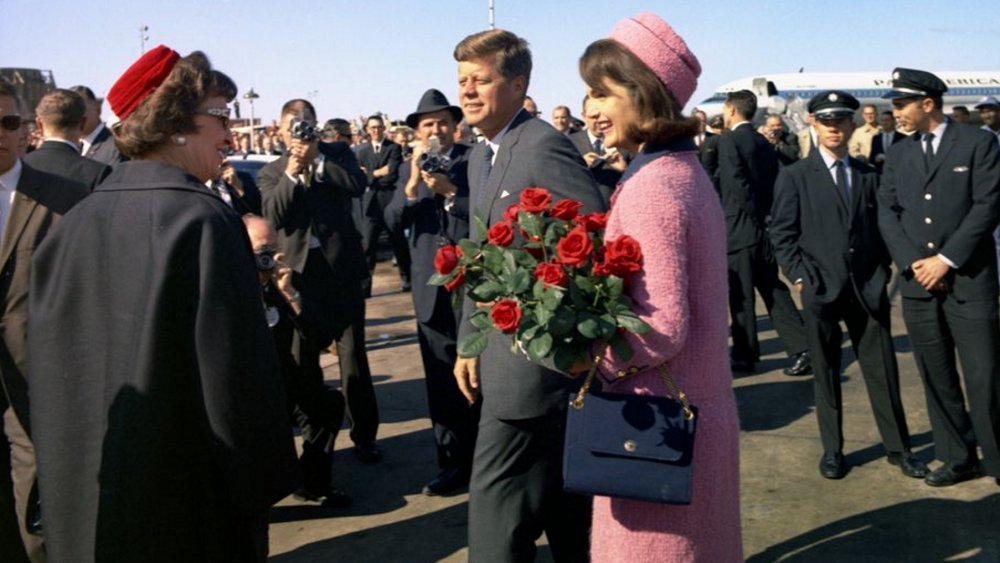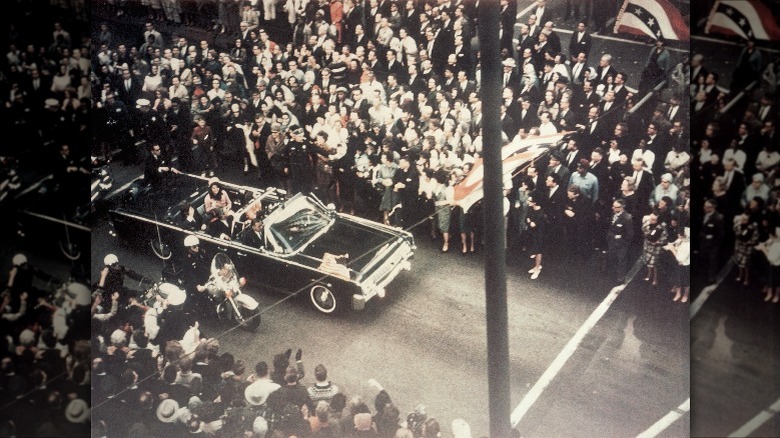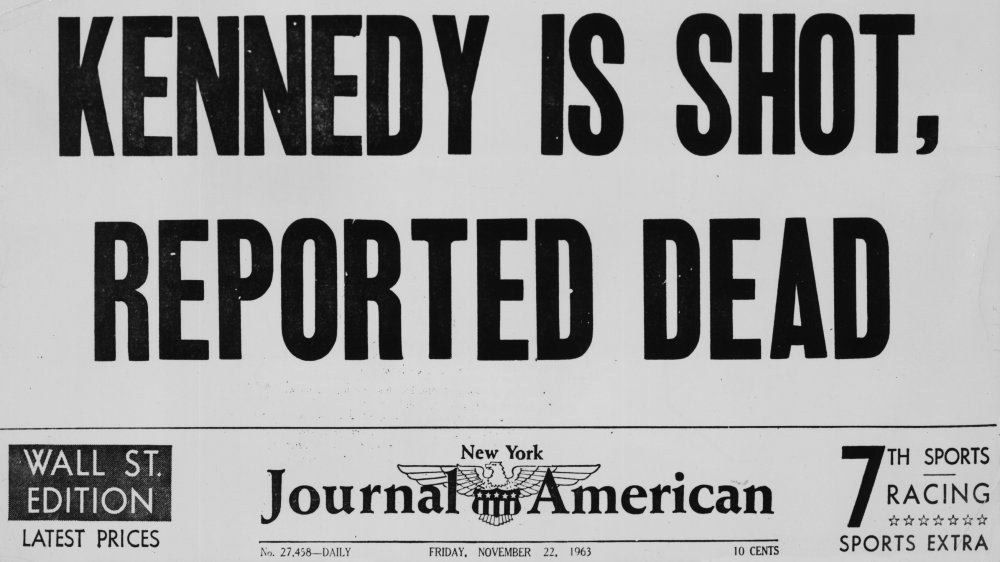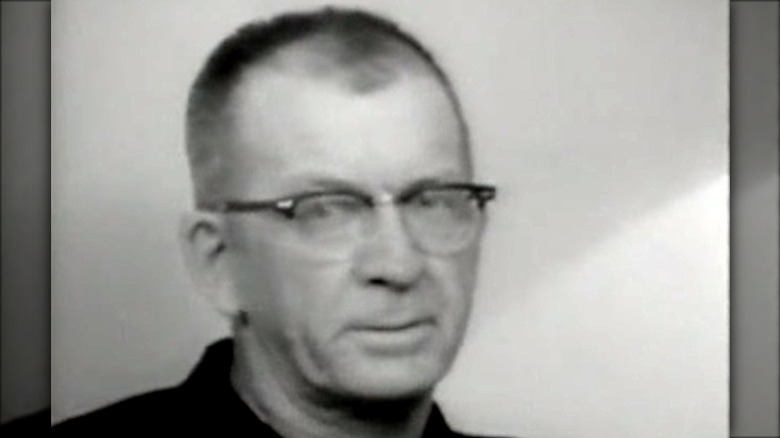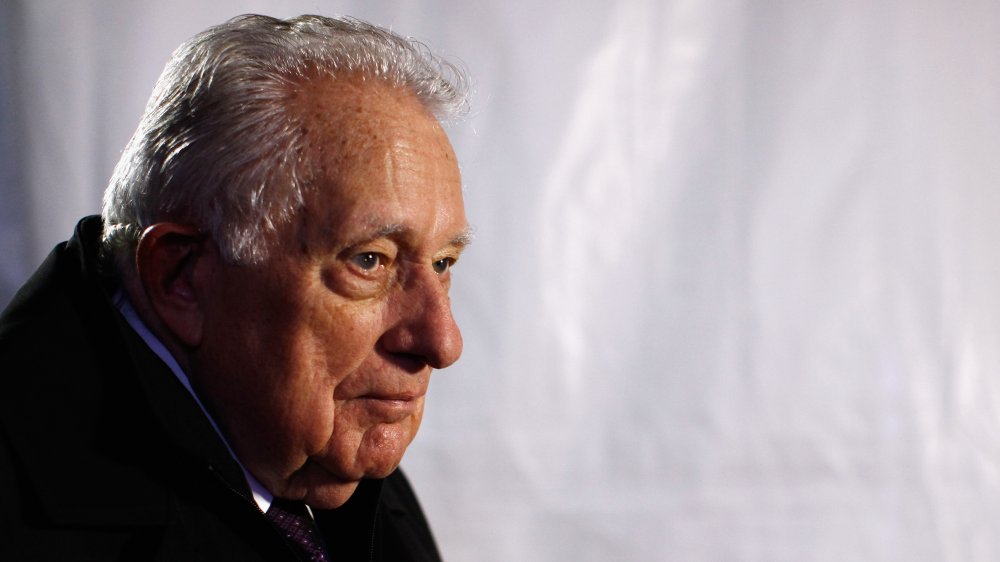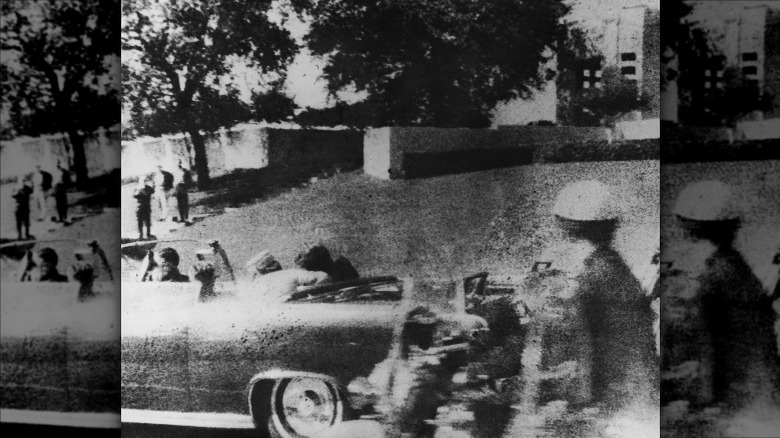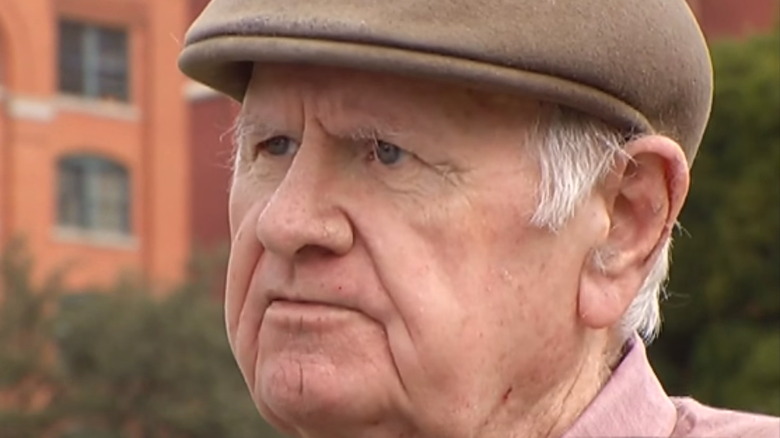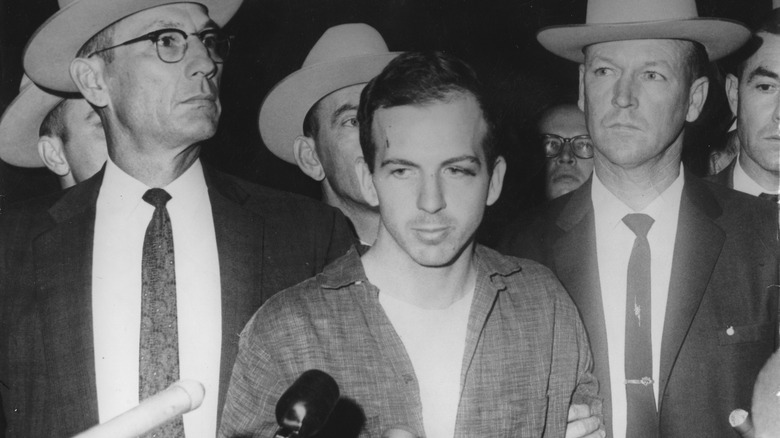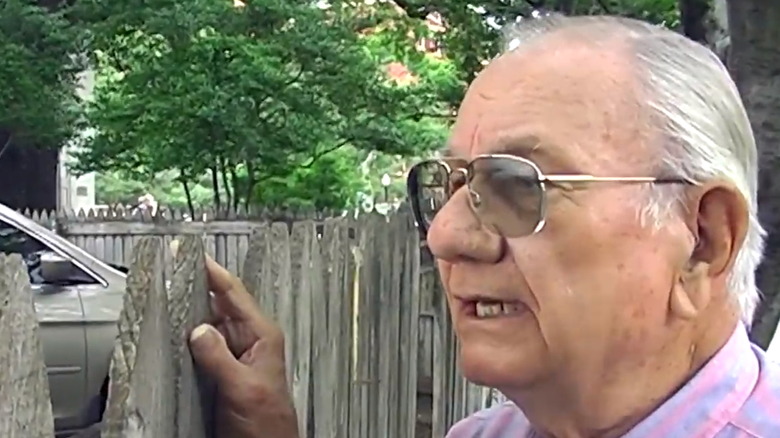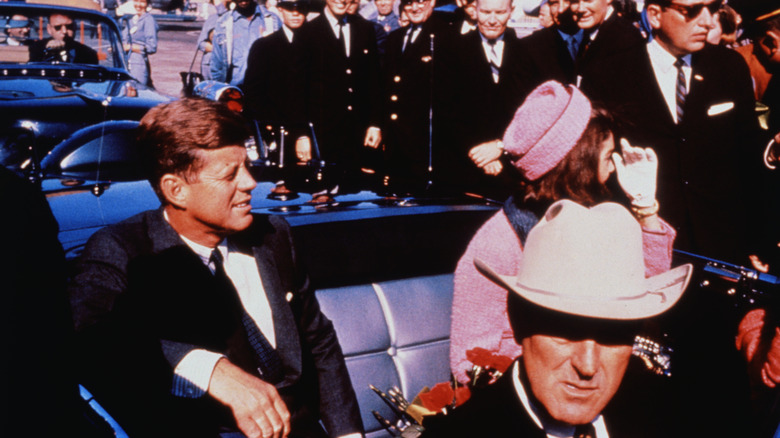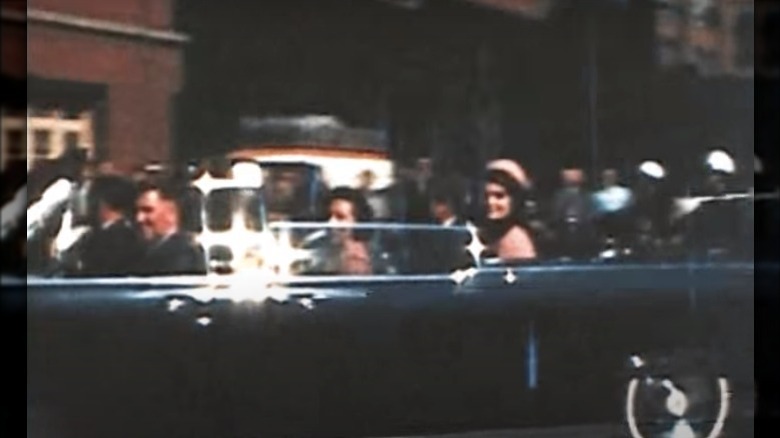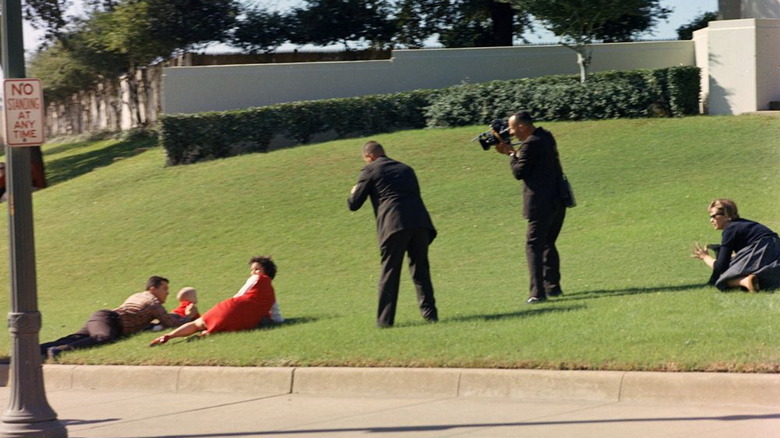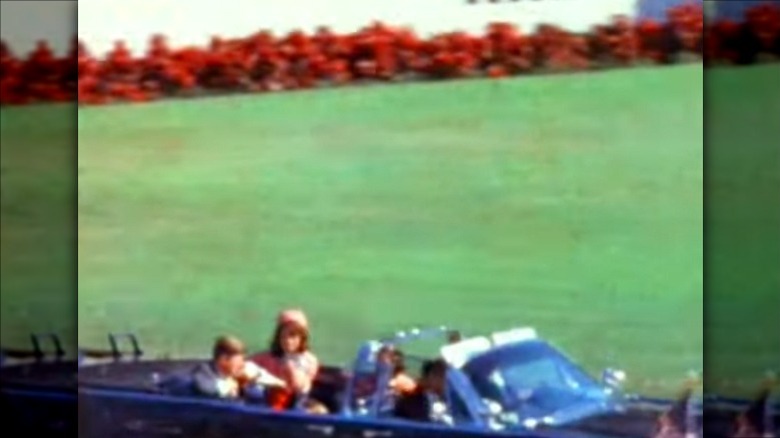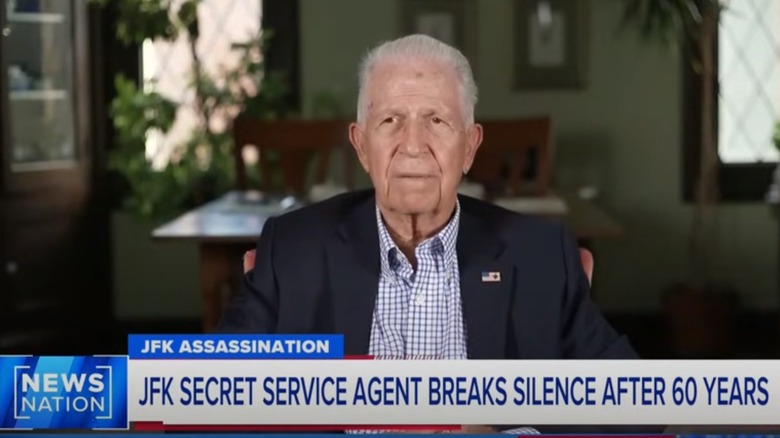What It Was Really Like Witnessing JFK's Assassination
On November 22, 1963, a sunny, autumn day in Dallas, Texas, turned into one the darkest chapters in American history when President John F. Kennedy was struck down by an assassin's bullet. Riding in an open-top limousine with First Lady Jacqueline Kennedy, Texas Governor John Connally, and Connally's wife Nellie, the 46-year-old president was on his way through Dealey Plaza to a luncheon with local businessmen. With an election just a year away, the president hoped to bolster support in the state. Charismatic Kennedy had failed to gain a majority of votes in Dallas in the last election, and he intended to connect with the city's people as intimately as possible.
Upon Air Force One's arrival at Northwest Dallas' Love Field, the Kennedys had been met with cheers, a far different reaction than they expected in the staunchly Republican city. There was a mood of celebration in the air as thousands lined the route through downtown to catch a glimpse of JFK and his trendsetting wife.
America seemed on the verge of an exciting new era. Yet, that bright, shining moment recalled by historians as "Camelot" was to come to an abrupt end. Turning onto Elm Street, the presidential motorcade collided with destiny as three gunshots rang out. President Kennedy was dead.
Although the nation would never completely heal from Kennedy's assassination, few individuals bear the scars of that bloody day as deeply as those who witnessed it. These are their stories.
Jenyce Gush skipped school to see JFK
Dallas native Jenyce Gush was only 14 years old when President John F. Kennedy was killed. Although she was too young to vote, she was nonetheless an admirer of the handsome, young president and his glamorous, socialite wife. On the morning of the presidential entourage's arrival, Gush and a friend were so determined to see JFK and Jackie, they skipped school. Positioning themselves along the parade route, the excited friends scarcely had time to finish their daily beauty routines before the president's arrival. "It was such an impulsive thing," Gush told ABC News, "We both had pink rollers the size of orange juice cans in our hair. We had no makeup and were right there on the curb as the motorcade came by."
Gush's spur-of-the-moment sojourn brought her within feet of the President and First Lady — close enough to notice both JFK's "bushy eyebrows" and that Jackie Kennedy's lipstick perfectly matched her now-famous pink outfit and hat. "We could have reached out and touched them if we wanted to," she remembers.
Still excited from their close brush with the Kennedys, Gush and her friend broke from the crowd and headed to a nearby drugstore where they noticed an obviously distraught woman in a car sobbing. Gush approached the crying woman who informed her that the president had been shot. "It was like a moment frozen in time," Gush says. "... How could that have happened? I was heartsick."
The Chisms were accidental witnesses of JFK's assassination
The Chism family, John, Marvin Faye, and their three-year-old son Rick were in downtown Dallas on a shopping trip — little Rick needed a new pair of shoes. At the last minute, they decided to watch the President and First Lady pass. By happenstance, the Chisms found themselves in the crowd on Elm Street directly in front of the Texas School Book Depository. In a 2013 interview with The New York Post, Marvin Faye Chism recalled the afternoon of the day she came to remember as the worst of her life. "I was standing in front of the Book Depository and the shots came over my head," she says. Like many witnesses, Mrs. Chism initially thought the gunshots were firecrackers until she saw the bullet strike Kennedy. "He was shot and his head went back," she recalls.
In the ensuing chaos, John Chism heard someone say that the assassin was on the train tracks. Hoping to catch the gunman, he made a dash for the grassy knoll only to be tackled by what he believed to be Secret Service agents. Chism and his family were taken to the police station and detained for 12 hours.
As reported by The Daily Campus, the assassination had a lasting impact on Rick Chism despite his young age. "For a long time I had this dream of somebody getting killed in a car, but I never knew what it was until I was thirteen years old," he says.
Orville Nix filmed history in the making
Orville Nix, a 52-year-old maintenance man employed at Dallas' Terminal Annex Building, was waiting to meet his wife, daughter-in-law, and granddaughter when he captured one of the most important and controversial pieces of film in American history. Positioned opposite Dealey Plaza's now-infamous grassy knoll on the corner of Main and Houston Street and armed with his Keystone movie camera, Nix filmed the driver's side perspective of the presidential limousine as the assassination unfolded.
Until his death in 1972, Nix maintained that the shots came not from the Book Depository, but from the fence at the crest of the grassy knoll. In an interview with investigator Mark Lane for the 1967 documentary "Rush to Judgment," Nix stated, "Most everybody thought [the shots] came from the fence behind the Book Depository." Nix's friend, Forrest Sorrels, Secret Service Special Agent in Charge of the Dallas district who was positioned in the backseat of the car immediately in front of the presidential limousine, was among those who concurred with Nix's assessment.
Nix's copy of the film along with his camera was confiscated by the FBI. According to Nix, the film returned to him appeared to have been altered. The original film, which Nix sold to United Press International for $5,000, was given to the United States government and has remained missing since its use in the 1978 House Select Committee on Assassinations. Along with the famous Zapruder film, Nix's footage was instrumental in the Warren Commission's investigation of the assassination.
Secret Service agent Clint Hill leapt into action to protect the Kennedys
In 1963, Clint Hill was a 31-year-old secret service agent on First Lady Jacqueline Kennedy's detail. With Mrs. Kennedy since 1961, the hungry, young agent was initially disappointed he wasn't assigned to the president. As Hill told CBS Television affiliate KPIX in 2019, that was where "the action" was. However, he soon realized that Jackie Kennedy was no typical First Lady. "She was very active, athletic, and very smart," Hill says. " .. We traveled the world. So I really had the best job of all the agents."
On the afternoon of the assassination, Hill was standing on the running board of the vehicle behind the president's limousine. In the seconds after JFK was mortally wounded, a distraught Jacqueline Kennedy clambered onto the vehicle's trunk to retrieve pieces of the president's skull. Agent Hill took action bravely leaping onto the president's car and assisting Mrs. Kennedy into the backseat where he shielded her and the president with his body.
Hill retired from the Secret Service in 1975. In the intervening years, he fell into alcoholism and depression and refused to speak about the assassination. Hill finally opened up about the darkest day of his life in 2009 with the help of journalist Lisa McCubbin with whom he has written three memoirs about his years in the Secret Service.
Still guilt-stricken by the experience, Hill told MSNBC in a 2017 interview, "I should have been able to get there quicker ... I was the only one who had a chance to do anything."
Mary Moorman wanted a photo of JFK for her son
Ricky Moorman, age 11, wanted to see the presidential motorcade wind through downtown Dallas, but he would have to miss it. Friday, November 22, was, after all, a school day. As a consolation, his mother, Mary Ann Moorman, promised to snap a photo of the president.
Mary Ann Moorman and her friend Jean Hill found the perfect vantage point to watch the procession pass through Dealey Plaza. Standing just feet from the curb directly opposite of the grassy knoll, Moorman and Hill would have an unobstructed view of the presidential limousine. The friends were excited to finally see the handsome, young president up close. As the motorcade drew closer, Moorman heard the cheering crowd get louder. Anxiously, she readied her camera. In a 2013 interview with The New York Post, Moorman recalled what happened next. "As the car turned the corner and came down past us, Jean hollered, 'Mr. President, look this way, we want to take your picture.' And I put the camera up and snapped the picture when I thought he was looking at me."
An unwitting witness to history, Moorman captured the moment Kennedy was struck by the fatal bullet. Years later, Moorman would tell documentary filmmaker Alan Govenar that, at first, she thought there had been a gust of wind because she saw Kennedy's hair lift. However, the First Lady's screams revealed the gravity of what she had seen. "Jackie hollered, 'My God! He's been shot!'," Moorman tells PBS. "We heard that so plain."
James Tague was hit by debris from JFK's assassination
The afternoon of November 22, 1963, began on a note of inconvenience for James Tague. The 27-year-old car salesman from Euless, Texas, was in Dallas to meet his girlfriend for lunch, but the president's visit had caused traffic through Dealey Plaza to grind to a standstill. Since it was apparent he was going nowhere for a while, Tague parked his car on Commerce Street near the triple overpass and stood near a bridge abutment to watch the motorcade.
As Tague watched the procession draw near, he heard a noise similar to a firecracker. In 2013, just a year before his death, Tague recalled what happened next in an interview with Dallas NBC affiliate KXAS-TV. "I was wondering what kind of an idiot would be throwing a firecracker with the president driving by," Tague said. "I'm standing there in disbelief at somebody throwing a firecracker — then, 'crack, crack!' Two rifle shots about a second apart and something stings me in the face." A bullet intended for Kennedy had struck a nearby curb, spraying Tague with fragments of concrete and lead. Realizing he was in the line of fire, he quickly dove for cover behind the bridge abutment.
Tague's injury and the damage to the nearby curb were instrumental in investigators' determination that the shots had come from the School Book Depository and that one round had missed the motorcade entirely.
Lee Harvey Oswald directed Pierce Allman to a phone
In 1963, Pierce Allman was the program director for Dallas radio station WFAA. In the days before the president's visit, Allman and other media representatives had coordinated with the FBI and law enforcement in preparation for the event. A recent incident in which United Nations ambassador Adlai Stevenson had been attacked by protesters had put the authorities on edge. However, concerns of a repeat of the incident that had earned Dallas the moniker of "city of hate" were forgotten as the president and First Lady stepped onto the tarmac at Dallas' Love Field. As Allman told The Sixth Floor Museum, the mood was celebratory as Dallas residents turned out in droves.
Returning to WFAA's downtown offices, Allman decided to walk over to Dealey Plaza to see the motorcade pass. Standing on the corner directly opposite the Book Depository, Allman excitedly shouted out, "Welcome to Dallas, Mr. President!" As the motorcade rounded the corner onto Elm Street, Allman heard shots ring out and saw Kennedy slump in his seat.
Allman knew he had to file a report for WFAA. Rushing into the Book Depository, he asked a man exiting the building where he could find a phone. The man jerked his thumb toward the lobby saying, "in there." Allman, the only journalist to report live from the scene, would later discover the man who directed him to the phone was assassin Lee Harvey Oswald.
Police officer Bobby Hargis was sprayed with JFK's blood
At the time of the assassination, Dallas police officer Robert W. Hargis was riding his motorcycle at the left rear side of Kennedy's limousine. In a 1973 interview, the former patrolman recalled that the route from Love Field to Dealey Plaza was so packed with spectators, the entire motorcycle section, part of the local security contingent, was forced to fall back behind the Secret Service car. It wasn't until the motorcade turned from Main onto Elm Street that Hargis was able to assume his assigned position behind and to the left of the president. As the procession turned left in the direction of the triple overpass, Hargis heard the first shot.
A year before his death, Hargis related his perspective of the assassination in the Dutch documentary "Back and to the Left: Escorting JFK." "Within five seconds, that second shot hit the president in the head," an emotional Hargis remembered. "And a plume of bloody matter — brain matter — went up, and I rode right through it."
Soon after, a friend noticed that Hargis was covered in gore. "... A buddy asked me, 'You got something on your lip?' and picked it off and it was a piece of the president's skull bone and his brains. I noticed I had it all over my uniform ... I felt bad about that."
Toni Glover's enduring anguish from the JFK assassination
For decades identified in photos only as "the girl in blue," Toni Glover didn't come forward with her story until 1995. Just 11 years old at the time, Glover was standing on a stone pedestal in Dealey Plaza across the street from the School Book Depository as the president's motorcade passed on Elm Street. On the 50th anniversary of the tragedy, Glover described her vantage point on November 22, 1963 to WNEP-TV. "I was five feet higher than anyone else, sticking out, screaming," Glover says. "And determined to watch that car every second I possibly could." Coming from a troubled home, she fantasized that if she could get JFK to wave or look at her, it would mean that he knew she existed, and "no one would hurt a kid that Kennedy knew."
"I went there with this magical thinking that just a wave and a smile would change my life forever," Glover tells The Morning Call, "and he did indeed look up and smile and wave and it took my breath away. I was just floating on air ... So I just kept watching the car as it went down the street and his head exploded."
Glover, now an English professor at the University of Scranton, struggled with depression for decades after witnessing the assassination.
Tina Towner: The incident's youngest photographer
Tina Towner, 13, stood across the street from the Texas School Book Depository with her mother, Pat, and father, James Towner. Out of school for the morning, Tina was tasked with capturing the motorcade with her father's 8 mm movie camera. Tina, intent on getting the best footage possible, was too consumed with operating the camera to get excited about the President and First Lady. As the procession moved out of her field of vision, Tina Towner stopped filming. No sooner had Towner lowered the movie camera, when she was startled by a sound she assumed was firecrackers, per the Herald Banner. Recognizing the sound of gunfire, a quick-thinking stranger pulled the teen to the ground.
Towner's film documenting the moments just before the assassination continues to reveal clues about the fateful day. In 2012, she wrote a book about her experience titled "Tina Towner: My Story as the Youngest Photographer of the Kennedy Assassination." James Towner avoided talking about the assassination for the rest of his life.
Bill and Gayle Newman were the nearest witnesses to JFK's death
Bill and Gayle Newman made a day of seeing the Kennedy motorcade with their young sons Billy and Clayton. As Gayle Newman explained at the JFK Lancer conference in 2016, they dressed in their "Sunday best" in anticipation of the historic event. Their day started at Love Field where they saw the Kennedys disembark from Air Force One. "We decided that we would go downtown somewhere, and we just happened to wind up in Dealey Plaza," Mrs. Newman said. Fate would place the Newmans mere feet from the motorcade, making them the closest civilian witnesses to Kennedy's assassination.
"Just as the car passed in front of us the third shot rang out and I remember seeing the side of President Kennedy's head blow off," Bill Newman told The Hot Springs Village Voice in 2018. Believing themselves to be in the line of fire, the Newmans dove to the ground shielding their sons with their bodies.
Abraham Zapruder's shocking film
Although Abraham Zapruder would become the most famous eyewitness to the Kennedy assassination thanks to his infamous film, the 58-year-old businessman left his movie camera at home on the day of the President's trip. As detailed by the Washington Post, Zapruder's secretary, Lillian Rogers, encouraged him to return home for his expensive Bell & Howell movie camera knowing her boss would regret missing the opportunity to catch the Kennedys on film.
Standing on a concrete abutment overlooking Elm Street, Zapruder was set to get the shot of a lifetime. Running for 26 seconds, Zapruder's film graphically captures the fatal shot and its aftermath. A cornerstone of the Warren Commission's investigation, the footage is one of the most studied pieces of film in history.
The assassination and his role in documenting it haunted Zapruder until his death in 1970. "I'm ashamed of myself," Zapruder said. "... It was an awful thing and I loved the president."
Paul Landis's long-secret memories could change the narrative
Paul Landis was one of the Secret Service agents on duty that fateful day in Dallas, and the events that unfolded under the wide Texas sky were so traumatic that within a year, he had left the service. He didn't speak about what happened for decades, and when he released his memoir in late 2023, what he shared wasn't just a rehashing of the same, oft-told tale, but it was pretty shocking.
According to Landis, the so-called "magic bullet" theory wasn't so magic at all: Rather than the long-accepted and wildly implausible theory that the same bullet that killed JFK also hit Texas governor John Connally Jr. multiple times, Landis says that he actually plucked a bullet from the seat in front of Kennedy — and behind Connally. Landis says that he grabbed the bullet when they had already reached the hospital, because he didn't want it to fall into the hands of someone looking for a souvenir. He put it on the stretcher by JFK, and says what happened to it after that is speculation.
"There was nobody there to secure the scene, and that was a big, big bother to me," he told The New York Times. "... So it was, 'Paul, you've got to make a decision,' and I grabbed it." The implications are staggering: Landis says he always believed Oswald acted alone, but the presence of the bullet that wouldn't have hit Connally has made him doubt.
